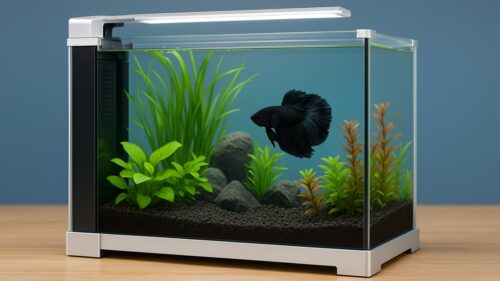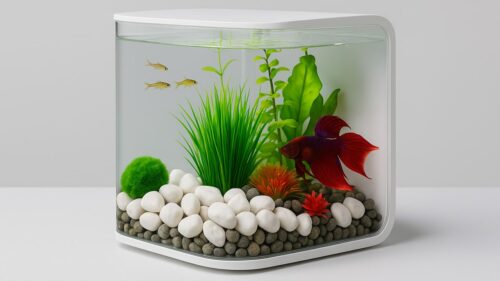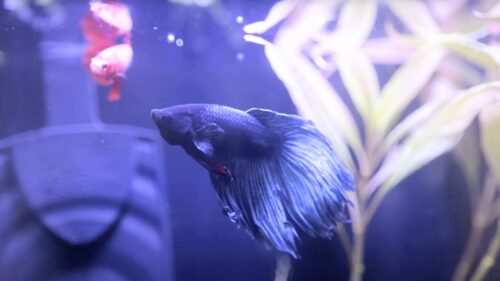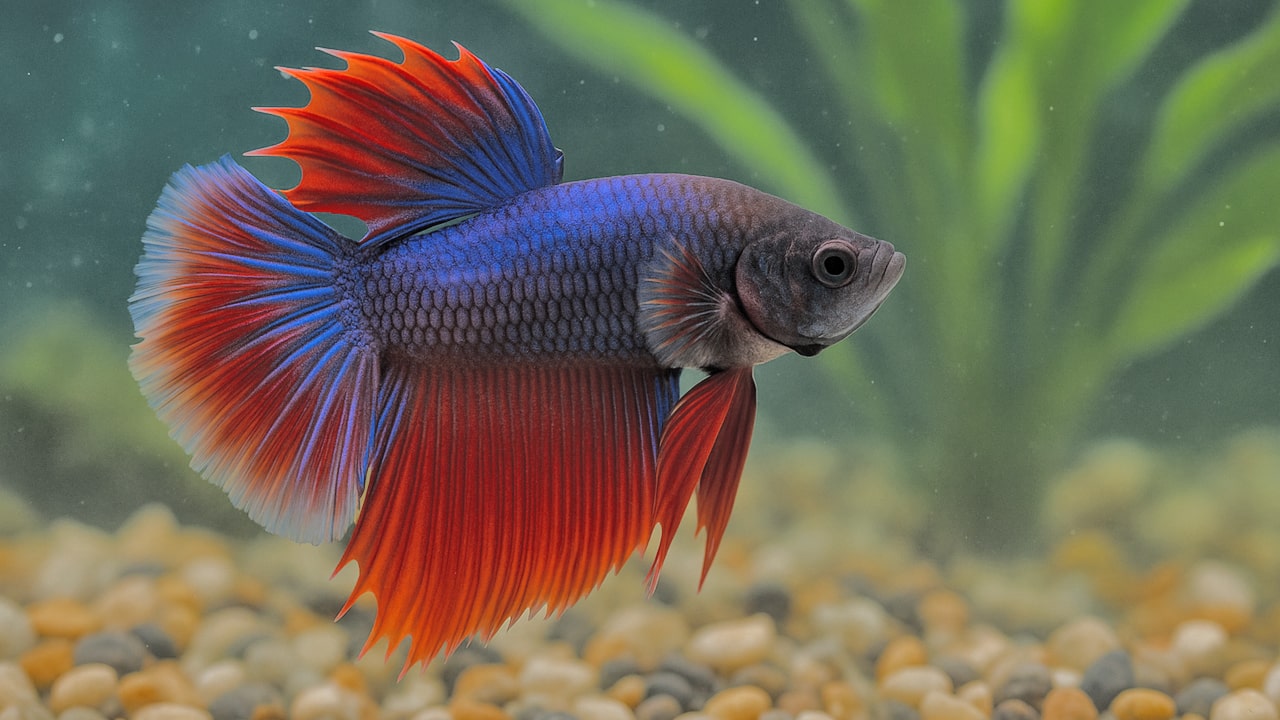Betta fish for beginners can seem challenging, but with the right setup and care, these colorful fish are surprisingly easy to keep.
Whether you’re just starting or looking for tips to improve, here’s everything you need to know about keeping betta fish successfully.
Tank setup for Betta Fish
While Betta fish are small and resilient, they still require a properly sized tank with the right equipment to thrive.
The tank should be long rather than tall. Betta fish are not strong swimmers and prefer horizontal swimming space.
A larger tank reduces the risk of water temperature fluctuations and allows for more stable conditions.
We recommend a 5 gallon (20 – 25 litre) tank or larger. This will give your Betta the best chance to thrive, ensuring a happy and healthy life.
Tanks like the Fluval Spec V or BiOrb Flow are excellent choices for beginners, as they offer good filtration, sufficient space and modern design that fits most homes.
Fluval Spec V tank

BiOrb Flow tank

Position the tank where there is no direct sunlight, as this can lead to temperature fluctuations and algae growth. A spot with indirect natural light is ideal for your Betta.
Filter for Betta Fish
While Betta fish can survive in unfiltered water for short periods, a gentle filter helps keep the tank clean and maintains stable water conditions, which is crucial for their health.
Choose a filter with adjustable flow or a gentle current, because strong currents can stress Betta fish and make swimming difficult. Sponge filters, small internal filters, or low-flow hang-on-back filters are ideal.
Position the filter so it doesn’t create a direct current in the main swimming area. If needed, use a sponge or baffle to soften the water flow, this keeps your Betta happy while maintaining a clean tank.
Does a Betta Fish need a heater?
Most Betta fish need a heater. They’re tropical fish, originally from the warm, shallow waters of Thailand, where temperatures stay pretty stable all year round.
The ideal water temperature for Betta fish is 76 – 80 °F (24 – 27 ° C). Anything lower can weaken their immune system, and sudden changes—up or down—can really stress them out.
A good heater keeps the temperature steady, especially if the room temperature in your home drops at night. Bettas don’t like surprises when it comes to water temperature.
In very small tanks, heaters can actually be risky. The water heats up and cools down too quickly, which can cause temperature swings that are harmful for your Betta.
If your tank is 5 gallons or more, a small adjustable heater is usually safe and reliable. Just make sure it’s appropriate for your tank size and has a built-in thermostat.
Fun fact: Some Betta owners use a digital thermometer to keep an eye on the water temperature.

Adding Substrate/Gravel and Plants
Beginner betta fish tip: Consider the size of your substrate carefully. Uneaten betta fish food food will sink and settle between the gravel pieces, leading to cloudy water and a dirty tank that is difficult to clean. Using fine gravel or smooth, small-grain substrate helps prevent this.
If you want to add live plants, you may need to look into a nutrient-rich substrate so they can grow and stay healthy. Before placing any plants, it’s a good idea to half-fill your tank with water, it makes planting a lot easier.
Adding some decorations
Add some fun decorations or even go for a themed setup, there are endless possibilities.
Betta Fish love little hidey holes, nooks, and crannies where they can swim in and out, or just take a break from the spotlight. That classic aquarium castle? It’s not just for looks, Bettas genuinely love hiding inside those little towers.
A few things to avoid
Terracotta plant pots – While they look great, they often have sharp drainage holes at the bottom. Bettas love to explore and might swim through those holes, many injuries have happened this way. If you really want to use one, make sure the hole is sealed or smoothed out completely.
Sharp (plastic) artificial plants – These can easily tear a Betta’s delicate fins. If you drag the plant along a piece of pantyhose and it snags, it’s too sharp for your tank. Stick to silk plants or live ones for safety.
Don’t put your betta fish in the tank yet…
Your tank might look ready with water, plants and decorations, but the water itself needs to be safe before your Betta can move in.
Ideal water condition for your Betta tank:
- PH – an ideal PH is 7
- Temperature – 76 – 80 °F (24 – 27 °C).
- Ammonia & Nitrite – should be 0
A fishless cycle is what is required next
What you need to do now is start a fishless cycle. This process allows beneficial bacteria to grow in your filter and substrate, turning harmful harmful fish waste (ammonia) into safer compounds. Skipping this step often leads to what’s called “new tank syndrome” – a sudden build up of toxins that can be deadly for fish.
It might feel like extra waiting, but cycling your tank first gives your Betta the best possible start in its new home.
And now you have set up a betta fish tank! Now comes the exciting part, choosing your new Betta from the pet store add it to the newly set up aquarium.
If your aquarium is larger than 5 gallons, you might even consider adding a tank mate or two. But before you rush out to buy more fish, here are a couple of important tips…
Never introduce lots of fish in one go, giving the tank time to adjust. Adding too many at once can upset the nitrogen cycle.
Bettas are also known as Siamese Fighting Fish for a reason. They can be aggressive and territorial, so not every tank mate is a good idea. Always research which fish are safe companions before adding them in.
It’s important to understand which fish can safely share a tank with a Betta.Never keep two Bettas together, avoid brightly colored fish with long flowing fins, and always make sure your Betta has at least 5 gallons of space to itself.
Don’t use tiny tanks or vases, the water in those gets dirty and toxic far too quickly, and there’s no room for your Betta to actually swim. Sure, Bettas can survive for a while in shallow puddles in the wild, but that’s not the same as living well. Surviving isn’t thriving, and your fish deserves better.
Hope your Betta tank is now set up perfectly and that you’ll enjoy many happy years with your new friend.
FAQ
How can I keep my Betta fish less stressed?
Keep your Betta in a 5+ gallon tank with a heater and gentle filter. Provide plants and decorations with hiding spots, avoid sudden changes in water conditions, and keep the tank in a quiet place away from constant tapping or loud noises. Consistency is key to a relaxed, healthy Betta.
Can I put a mirror on the back of my Betta fish tank?
No, a full mirror background is not recommended. Your Betta will constantly think another male is in the tank, which can cause severe stress. Short, controlled mirror sessions (a few minutes) can be enriching, but never keep a permanent mirror.
How long does it take to fishless cycle a 5-gallon Betta tank?
A proper fishless cycle takes 4 – 6 weeks on average. This allows beneficial bacteria to establish and keeps ammonia and nitrite at safe levels before adding your Betta. Testing water regularly with a liquid test kit is the best way to track progress. Be patient.
Why is my male Betta fish staying at the bottom of the tank?
A Betta resting at the bottom can be a sign of stress, poor water quality, low temperature, or illness. Check water with a liquid test kit, keep the temperature at 76 – 80 °F (24 – 27 °C), and watch for fin rot or damage. If his condition doesn’t improve, consult a fish vet.
About the author
Samantha Bailey
Samantha is a betta fish enthusiast and hobby aquarist. She started keeping bettas in college and quickly fell in love with their vibrant colors and unique personalities. Over the past 7 years, she has gained hands-on experience with tank setups, water care, and fish health, which she now shares with other beginners through her blog.

